After World War II, Villedieu rebuilt its copper industry and flourished.
US and international interest in buying French cookware hit a high point from the 1960s to the 1990s and Villedieu responded by cranking out a lot of copper pots and pans. The challenge for a vintage copper buyer is that a lot of these pans look virtually identical: a small local chaudronnerie would look to a machine shop such as Multiform (founded in Villedieu in 1947 to make copper for the cookware industry and still in business today) for volume production of spun or deep-drawn pan bodies, and then the chaudronnerie would finish them with its own handle and stamp. (Multiform was itself part of GAOR and CVD.)
If you’re shopping on eBay and Etsy, these pans can all look alike in photos: smooth copper surface, iron or brass handle, silvery metal interior. After all, the purpose of this machinery is to produce pan bodies of absolute consistency. But while the majority of the copper from this period is comparable (based on size, thickness, and lining), some of the chaudronneries seem to have tried to differentiate themselves with innovative products that, in my opinion, can translate into differences in usability and collectability.
For that reason, I’ve gathered photo examples of pieces with stamps and cobbled together what I know of their history and production. I apologize for the lack of information on some of them but details are sparse. I welcome more history if you know it.
- Atelier du Cuivre
- CVD
- Delalande
- GAOR
- Garnier
- Guillaumet
- Havard — please see my field guide
- Le Maitre
- Lecellier — please see my field guide
- Matillon
- Mauviel — please see my field guide
- ML
- Roblin
- Serie Spéciale Villedieu — please see Atelier du Cuivre
- Veritable Villedieu
- Villedieu (for Havard)
- YG
Atelier du CuivreThe Atelier du Cuivre is one of three cuivreries currently producing copper in Villedieu (the others being Mauviel and Havard). This company began as Lefèvre Frères, a venerable Villedieu copper maker with history back to 1900. That firm survived to 1980 when Maurice Lefèvre (see ML below) sold it to Étienne Dulin who renamed it l’Atelier du Cuivre and in 1985 opened the workshop to the public. You can visit the atelier today in Villedieu; they make lovely tin-, stainless-, and silver-lined copper pots and pans. (I suspect they work with the Villedieu machine shop Multiform for production runs of deep-drawn and spun pots and then assemble them at the workshop.) Atelier du Cuivre pans are easily identifiable by their stamp, but I believe they also produced “Serie Speciale Villedieu” pans as well. |
|
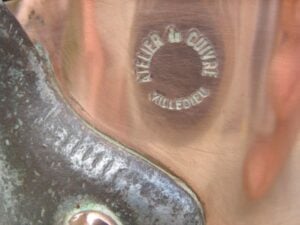 |
This is a simple round cartouche with the words “Atelier du Cuivre” above and the word Villedieu below.
(Source: Etsy) |
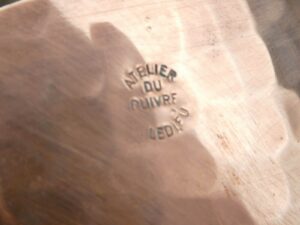 |
This is another configuration of the round cartouche. In this version, the words Atelier du Cuivre are arranged in three lines above the word Villedieu.
(Source: eBay.) |
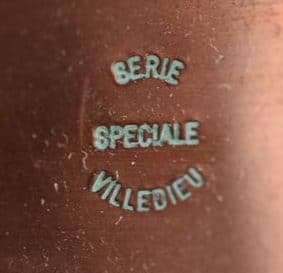 |
“Serie Speciale Villedieu” are tin-lined pans. I believe these are products of the Atelier du Cuivre from an example with this stamp and second “Atelier du Cuivre” stamp on the same piece, but that may have been an oddity. I’m still looking into this and if you know more I would welcome the information so I can correct this.
(Source: Etsy.) |
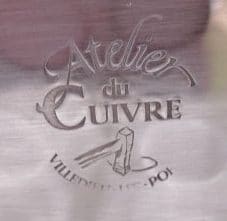 |
This stamp reproduces the company’s current logo. I think this is the most modern of the stamps.
(Source: Etsy.) |
| Atelier du Cuivre’s iron handle designs vary. In addition to conventional two- and three-rivet handles, the company also brazes or welds their handles to the exterior of the pot, producing a smooth rivetless interior. (I believe Multiform does this work for them.) The “Serie Speciale” pieces often have two-rivet handles in a vertical orientation, either fully riveted or welded. | |
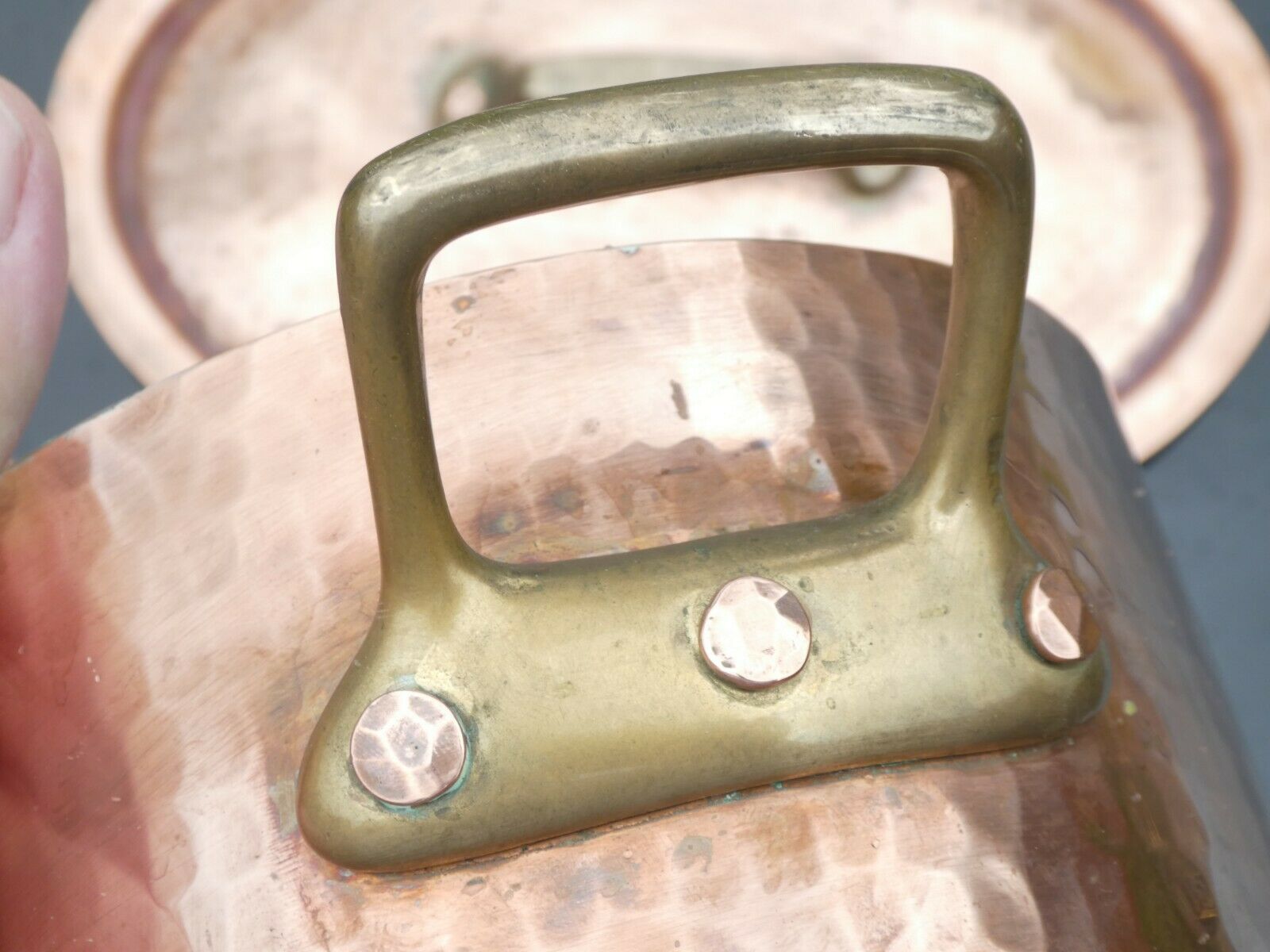
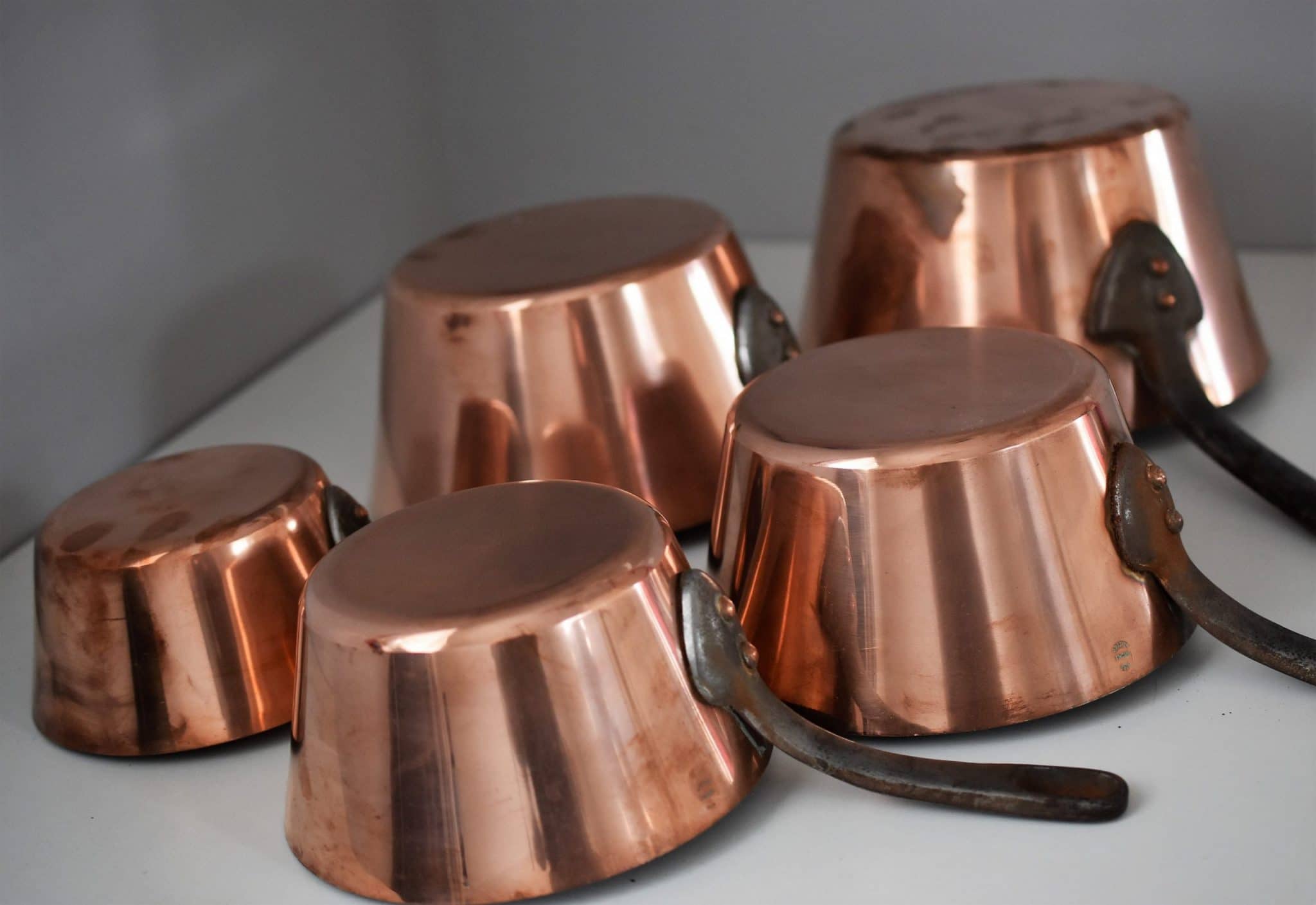
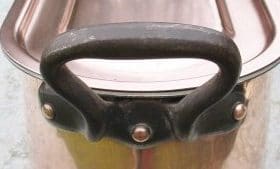
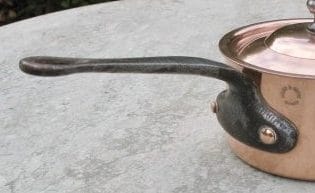
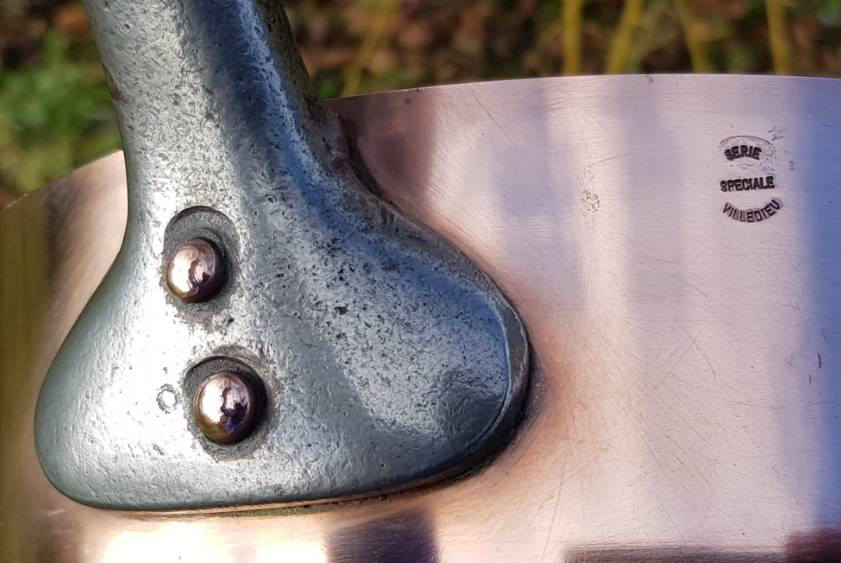
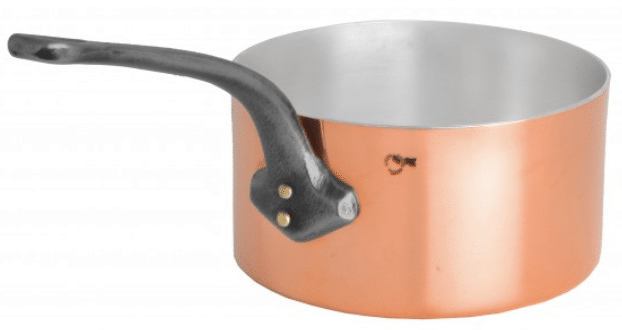
|
|
CVDThis was the name of a brand of copper by GAOR, and I believe the “CVD” stands for “Cuivres d’Art Villedieu” with the initials rearranged in monogram style. I’m not sure what warranted a separate brand name for this line; the name cuivres d’art implies decorative copper, but so far I have seen it only on traditional tin-lined copper cookware. |
|
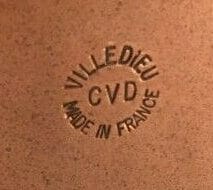 |
The stamp is a simple round text cartouche. The initials “CVD” are in the middle, with “Villedieu” above and “Made in France” below.
(Source: Etsy.) |
| What’s distinctive about CVD handles is that they tend to be low-slung, mounted just a few centimeters above the base of the pan. This is a nice positioning to create leverage when moving and tipping the pan. The rivet treatments can vary; some rivets protrude, while others are shaped into smooth buttons or bullets. | |
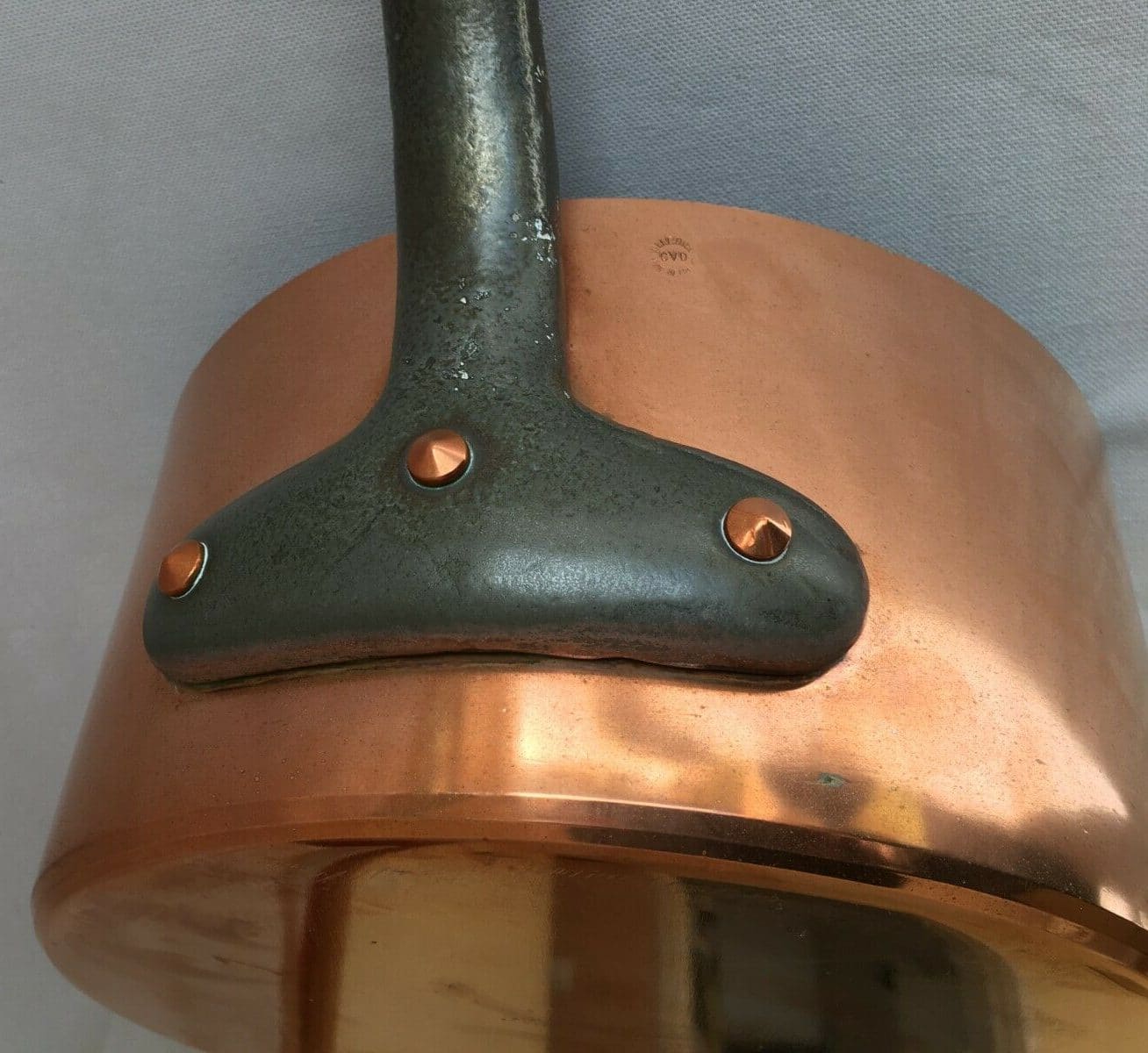
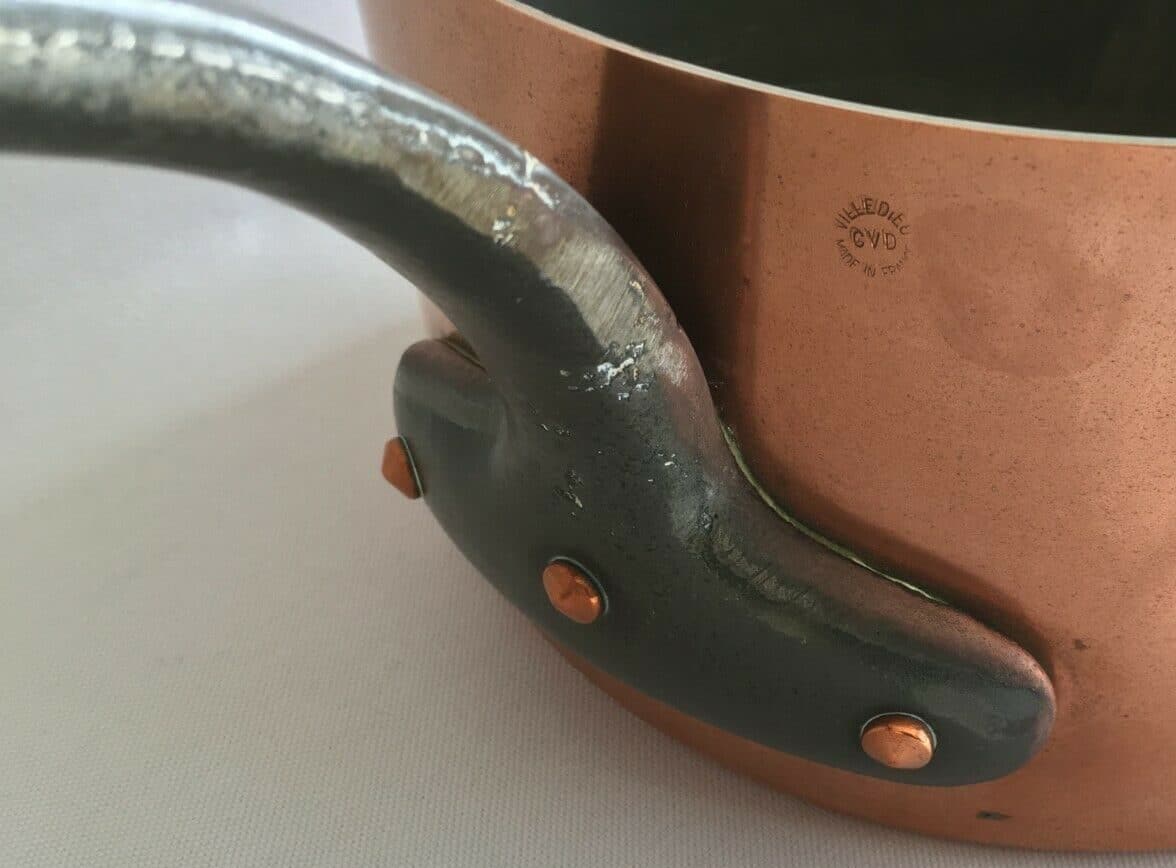
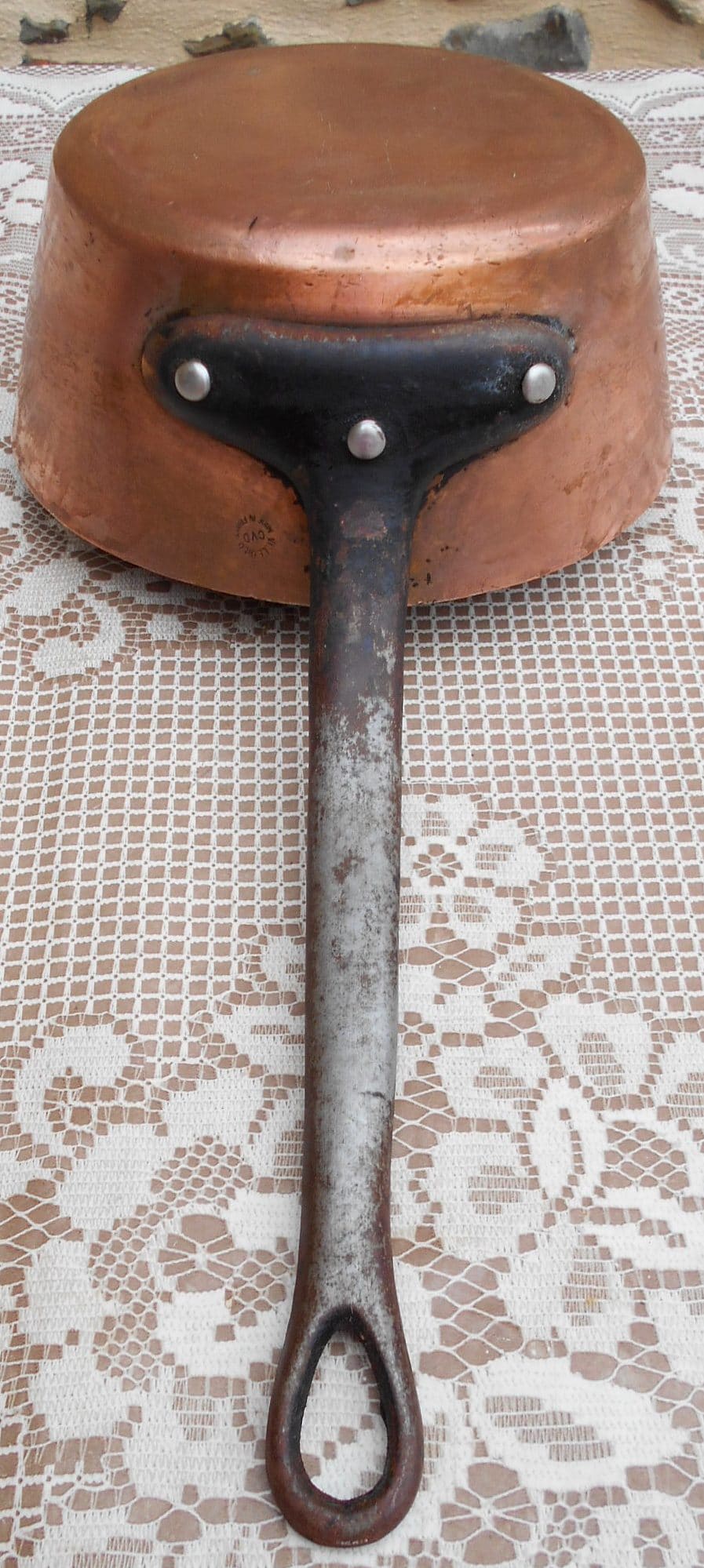
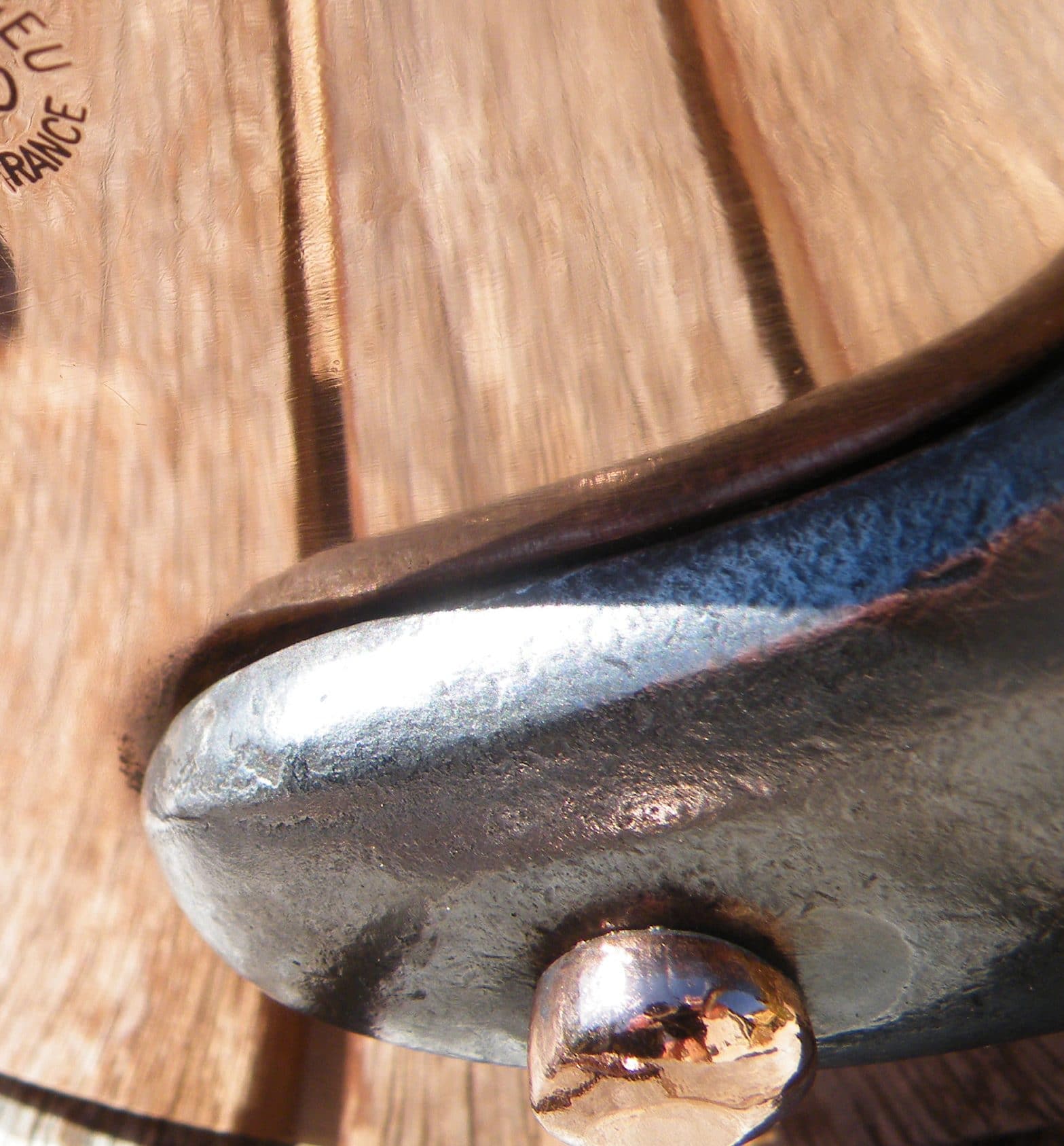
|
|
DelalandeMarcel Albert Auguste Delalande had a chaudronnerie at 16 Rue des Ecoles in Villedieu from 1964 to 1989. The firm operated “Creations de M. Delalande” from 1985 to 1990. |
|
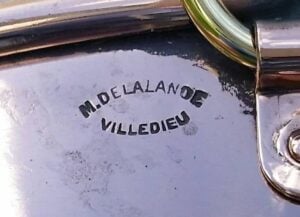 |
The stamp is a simple oval of text with “M. Delalande” on top and “Villedieu” below.
(Source: Etsy.) |
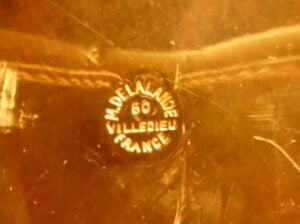 |
This version of the stamp is circular, with M. Delalande on top and France below. In the center is “50 Villedieu,” reminiscent of the GAOR 50 line of copperware. I suspect that the number 50 is for the postal code of Normandy.
(Source: Etsy.) |
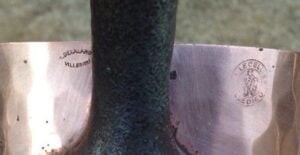 |
This is a head-scratcher: here is the oval M. Delalande stamp next to a L. Lecellier stamp. I have no idea how stamps from these two places ended up on one pot. Perhaps L. Lecellier bought Delalande’s stock when the company closed in 1990; another possibility is that Delalande operated a retail storefront and on occasion re-stamped other makers’ goods as its own.
(Source: eBay.) |
GAOR
I believe GAOR was Pitel’s line of cuivres d’art, the term for decorative items like vases, platters, and so forth. I have seen business records for GAOR dated to 1937. Georges Émmanuel Jules Pitel, born in 1919, took over the business and organized it into two ventures. The machine shop became Multiform (which operates to this day), and GAOR continued to produce copper to include cookware. There was also the “GAOR 50” line; I’m not sure what the significance is of “50” except that it is the postal code for Normandy and may be a nod to the “made in Villedieu” movement. 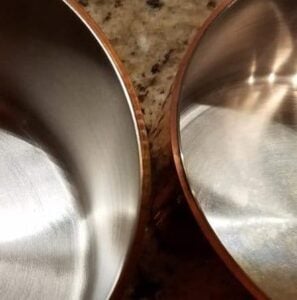 One notable element of GAOR cookware is that its stainless-steel-lined pots do not appear to be made of copper-steel bimetal. I have never held a GAOR pan in my hands to inspect it, but a Hungry Onion poster noted that the stainless lining on his GAOR pan was unusually thick (.8mm, much thicker than the conventional .2mm) and that the steel projected a fraction of a millimeter above the copper rim. He theorized that the copper and steel were not fused — as is bimetal — but rather that a separate thin steel pan was nested inside an outer copper pan. The photo on the right shows this — look at how thick the copper is, and then how the steel lining seems a bit taller than the copper. TJFRANCE has seen examples of copper-steel pots delaminating, and my suspicion that it is these pots that are most liable to do so. Another distinctive feature of GAOR pans are their rivetless construction. Their handles are brazed or soldered to the exterior and do not have rivets that penetrate to the interior. I suspect this was a GAOR innovation leveraging the skills of Multiform’s machine shop; the Atelier du Cuivre seems to have adopted this technology as well. I continue to investigate whether the Atelier du Cuivre licensed this technology from GAOR or purchased it outright — I don’t know how or when GAOR closed its doors, and it’s possible the Atelier du Cuivre acquired the entire company. GAOR was entered as a French company in 1956 and struck off in 1988, right when Étienne Dulin was reinvigorating Atelier du Cuivre. |
|
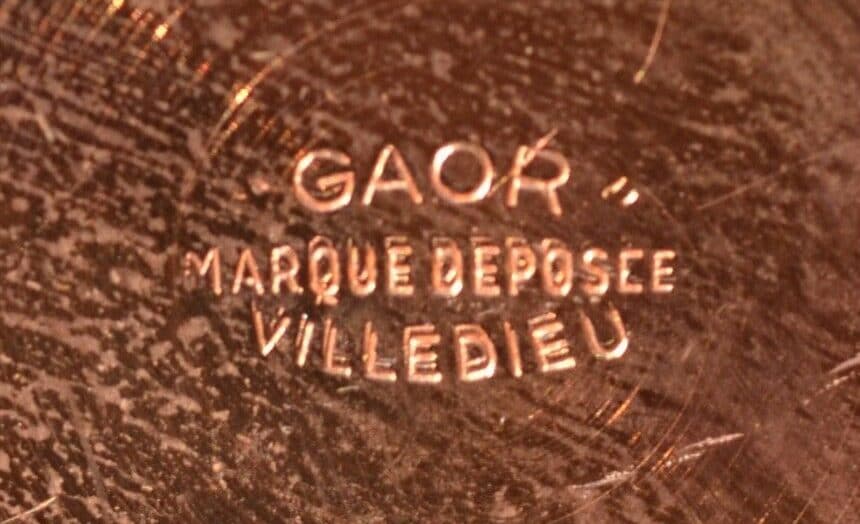 |
I suspect this is the earliest version of GAOR stamp as it does not have the “50” notation.
(Source: eBay.) |
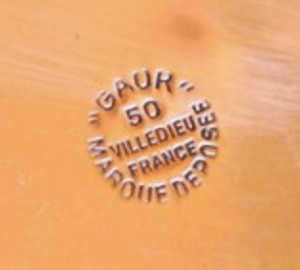 |
This is the round version of the GAOR 50 stamp. As above, I suspect the “50” is a nod to Normandy’s postal code.
(Source: eBay.) |
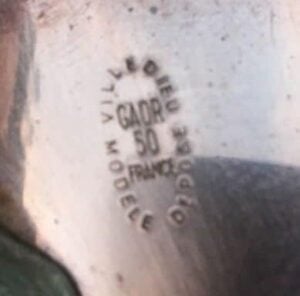 |
This is the lozenge-shaped version of the GAOR 50 stamp.
(Source: eBay.) |
| GAOR’s pans can be traditional tin-lined with three-rivet handles, or lined with stainless steel with the rivetless handles. Note that the rivetless handle design is identical to those on Atelier du Cuivre pots. | |
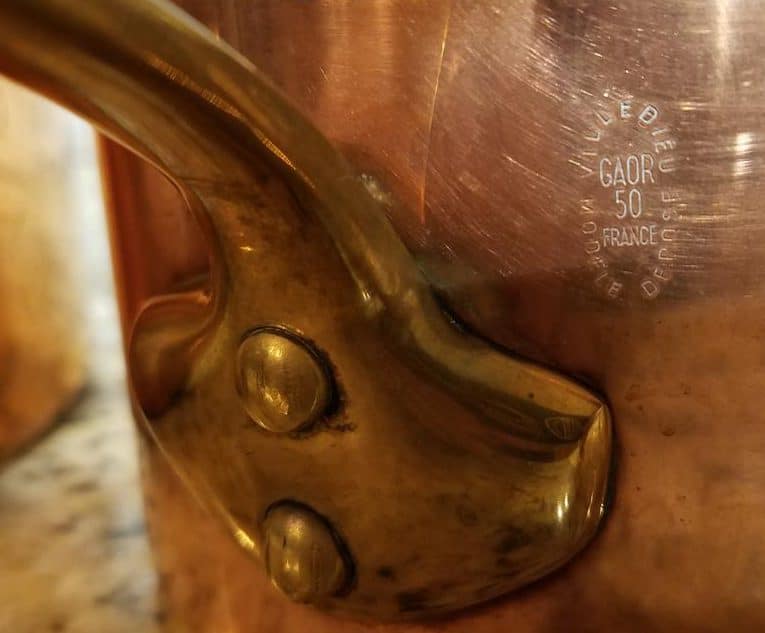
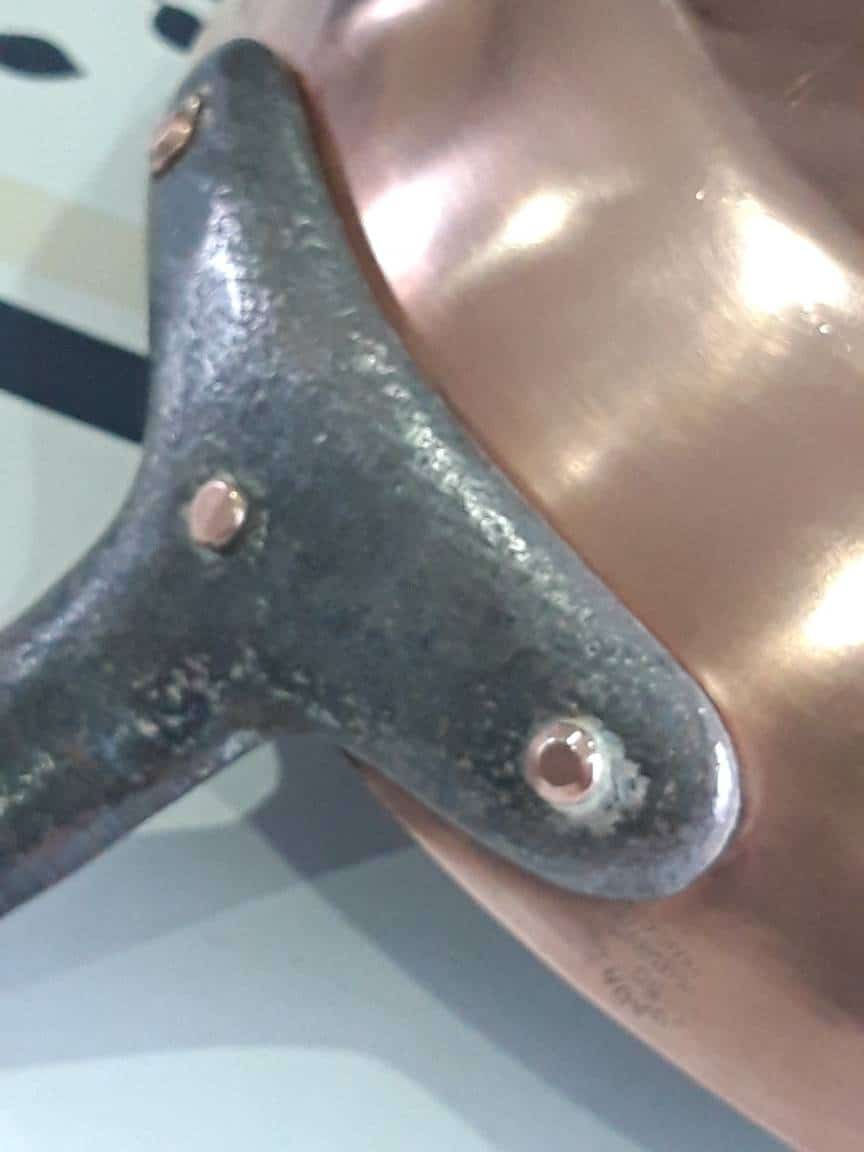
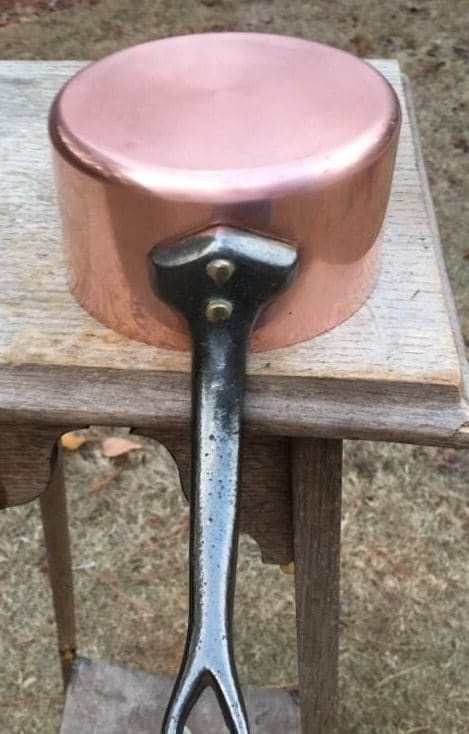
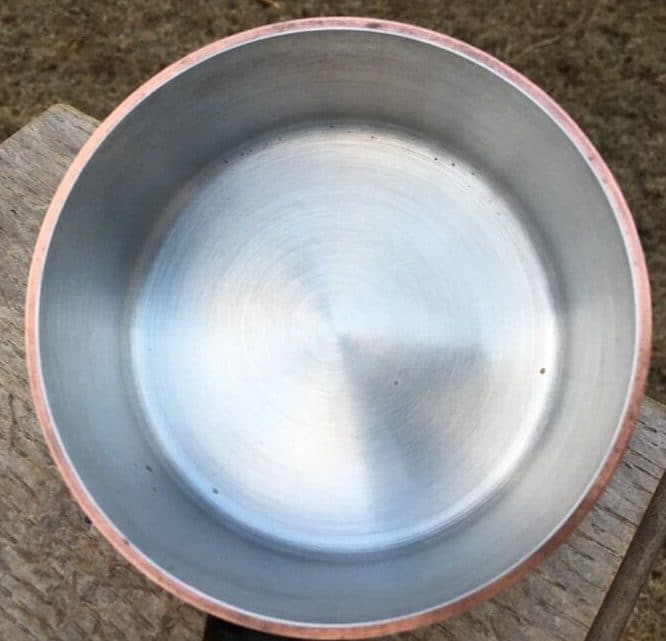
|
|
GarnierI believe copper with this mark was made for Gerard Georges Louis Garnier and his general retail store at 8-10 Place de la République in Villedieu from 1959 to circa 1988. |
|
 |
The stamp is two lines of simple text: “G. GARNIER VILLEDIEU.”
(Source: Etsy.) |
GuillaumetI think this is a stamp made for André Guillaumet, who had a bar at 20 Rue Carnot in Villedieu. The business was registered in 1979 and closed in 1994. (This location currently is a store called La cuivrerie sourdine.) I found this stamp on a rolled-rim jam-making pan. (Why would a bar have a jam pan? Perhaps it was selling copper to go with the cocktails?) |
|
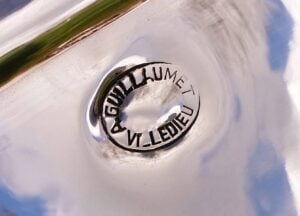 |
The stamp is an oval cartouche with “A. GUILLAUMET VILLEDIEU.”
(Source: Etsy.) |
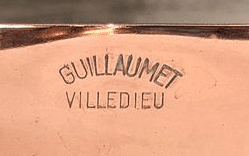 |
Here’s another stamp, this one more plain. Unfortunately I don’t know if this stamp is earlier or later than the one above, but stylistically this looks like other stamps of the 1980s and 1990s, so if pressed I would guess it was later.
(Source: Etsy.) |
Le MaitreI am having a really hard time finding out anything about this company. I’m not even sure if it’s a copper maker or a store. |
|
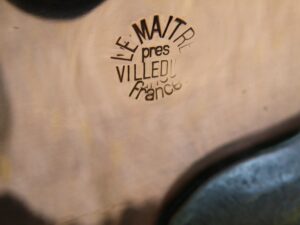 |
The stamp says “LE MAITRE près VILLEDIEU france,” meaning that it’s close to Villedieu but not necessarily in it. I have a feeling this was a restaurant or a store, not a copper maker, but that’s just a guess.
(Source: Etsy.) |
Matillon
Michel Matillon was born in 1925. In 1959, he and his wife Therèse opened a store at 3 Rue Carnot from which they sold copper that Michel worked in a workshop at the cour Dolley. He retired in 1989, but his wife continued to run the store, and then their daughter Catherine took over in 1998. She retired in 2018 and the store closed. Jean Matillon was the son of Pierre, and he produced copper under his own name as well. I don’t know very much about him except that he must have been around the same age as Michel. |
|
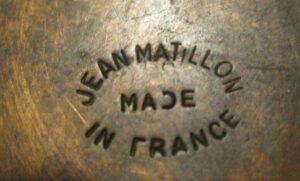 |
This is the stamp for Jean — a simple text oval with “Jean Matillon Made in France.”
(Source: eBay.) |
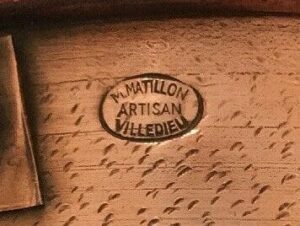 |
This is Michel’s stamp — an oval cartouche containing the words “M. Matillon Artisan Villedieu.”
(Source: eBay.) |
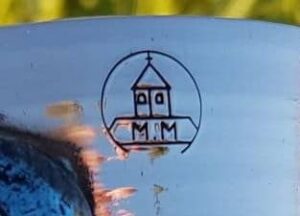 |
This is a crazy wild guess but I suspect that the “M.M.” here stands for Michel Matillon. I have no proof of this other than it’s from Villedieu and the timing and initials seem right.
(Source: Etsy.) |
MLI believe this is the stamp of Maurice Lefèvre for the period of time that he ran a chaudronnerie. He took over Établissements Lefèvre Frères and ran it until 1980 when he sold it to Étienne Dulin (who transformed it into l’Atelier du Cuivre). |
|
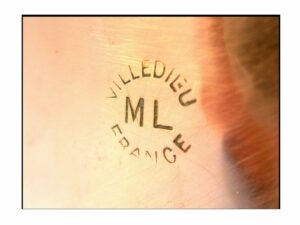 |
The stamp is composed of the initials “ML” within a circle formed by the words Villedieu and France.
(Source: eBay.) |
RoblinAuguste-Adolphe Roblin (b. 1839) and his son Auguste (b. 1873) formed Auguste Roblin père et fils and operated a chaudronnerie in VIlledieu into the 1930s, but I do not know who “E. Roblin” could have been. There was a Pierre Adolphe Roger Émilien Roblin who operated an industrial metalworking shop from 1965 to 1982; that company eventually because the modern-day Roblin that manufactures high-end air handling systems. But the stamp sample I have below is from a decorative piece that looks much older (though it could of course have been artificially “antiqued”). |
|
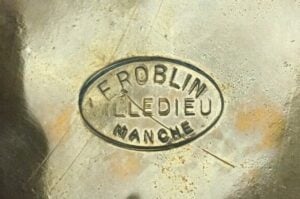 |
This is the only E. Roblin stamp I have found, and it’s on a decorative (and possibly antique) water jug. The stamp has “E. Roblin” above the words Villedieu and Manche. (Manche is the French term for the English Channel as well as the province of Brittany where Villedieu is located.)
(Source: eBay.) |
Veritable VilledieuVilledieu’s government is acutely aware of the importance of its history in driving tourism and commerce for the town, and I believe for a period of time there was an overt effort to create a brand around which small individual shops could organize. I suspect this stamp may be an initiative like this — I’ve seen it on its own, but also with initials inside, as though a particular craftsman was adding his signature. The stamps themselves look to be different physical objects. I mention this because it appears not as though the copper came through one shop, but rather that multiple shops used similar stamps. I wish I knew exactly which shop or shops that was, of course. The work continues. |
|
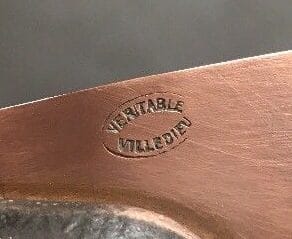 |
This is the plain version of the stamp, simply the words Veritable Villedieu within an oval cartouche.
(Source: eBay.) |
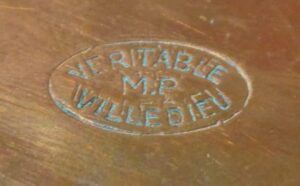 |
This version has the initials M.P. within the cartouche.
(Source: Etsy.) |
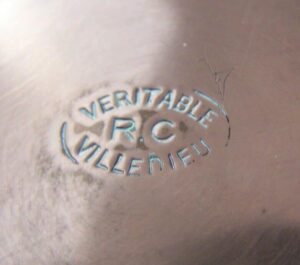 |
This version has the initials R.C. in the cartouche.
(Source: eBay.) |
Villedieu (for Havard)I was not sure what maker was behind this stamp, but reader Martin has pointed out multiple examples of pieces with this stamp that are physically identical to the work of Havard. Based on this — and my sudden realization that the lines form the letter “H” — I agree with Martin that it’s a Havard mark. I have an extensive Field guide written for Havard with much more detail on this maker. |
|
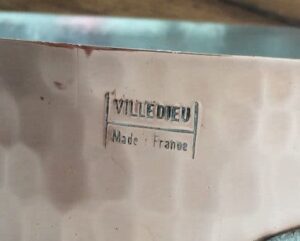 |
The stamp consists of the words “Villedieu” and “Made in France” with straight horizontal and vertical lines forming the letter H.
(Source: eBay.) |
YGI believe this stamp was made for Yves Gautier. He and his wife Francine have operated a store at 28 Place de la République in Villedieu from 1977 to the present day. I don’t know whether they also made copper; the Gautier name is certainly an old one in Villedieu, but I suspect the shop bought copper from Multiform or another supplier. Yves seems like an interesting character. In 1989 he formed the Association des artisans et fabricants du cuivre de Villedieu-les-poêles. His effort to trademark this name in 1996 was rejected by the French trademark office. In 1994, he filed an application to trademark Villedieu du vrai (“the real Villedieu”), a trademark that had been held by the mayor’s office in Villedieu; his application was rejected. |
|
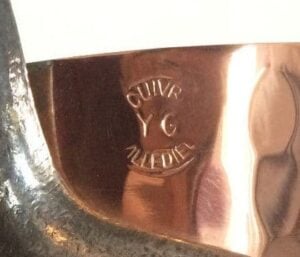 |
The stamp is a circle with the initials YG within the words Cuivre and Villedieu. The pot is a traditional tin-lined pot in hammered finish.
(Source: eBay.) |
 |
Bill Cox of Normandy Kitchen Copper provided this example of the stamp, noting how the slight mis-stamping makes the “YG” look like a single “G”.
Thanks, Bill! |
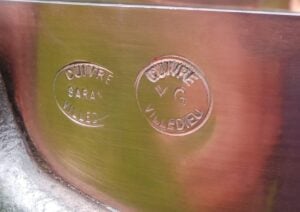 |
I include this second stamp for my own curiosity. I believe the YG stamp is the same as the one above, but the second stamp has me flummoxed. It says “SARAN” but I can’t find record of a company ever by that name in Villedieu.
The pot is stainless-lined. (Source: Etsy.) |
As with all this amateur research work, I would really welcome more information about any of these places. Please leave a comment on this page or contact me.
Notes
Attentive readers will note that I changed the title of this post. Originally I called it “‘Modern’ copper in Villedieu,” but I since had occasion to think through my definitions of antique, vintage, and modern, and I don’t want to call copper of this period modern any more. It’s a little confusing even to me because copper of the period discussed in this post looks modern in the mid-century modern sense, but it’s still vintage — it’s more than 20 years old. Anyway. My apologies.
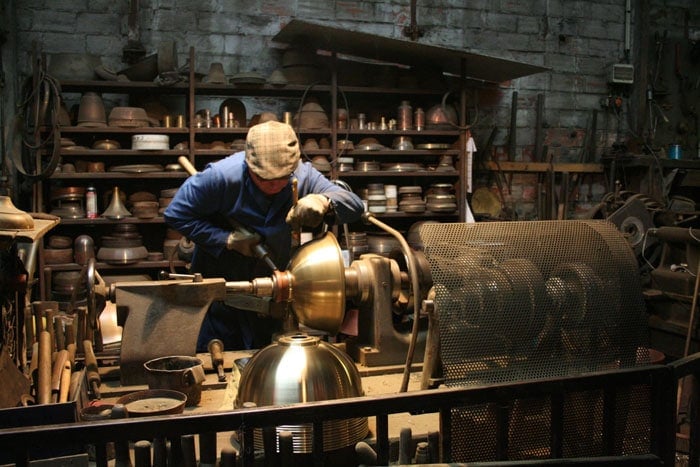
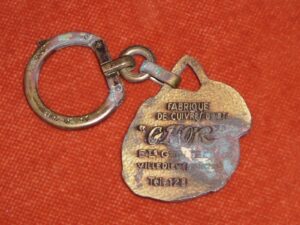 GAOR made copper cookware in Villedieu along with a whole host of decorative platters, buckets, baskets, lamps, and more. The company’s roots are in the Pitel family, an old Villedieu name; Georges Pitel founded Établissements Georges Pitel in the early 1900s, a metalworking company offering ferblanterie, zinguerie, plomberie, tolerie, et fumisterie (tin plating, zinc plating, plumbing, rolling mill, and chimney and exhaust systems).
GAOR made copper cookware in Villedieu along with a whole host of decorative platters, buckets, baskets, lamps, and more. The company’s roots are in the Pitel family, an old Villedieu name; Georges Pitel founded Établissements Georges Pitel in the early 1900s, a metalworking company offering ferblanterie, zinguerie, plomberie, tolerie, et fumisterie (tin plating, zinc plating, plumbing, rolling mill, and chimney and exhaust systems).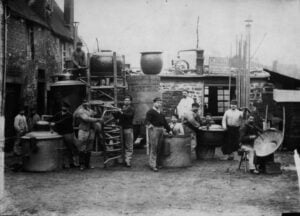 Pierre Matillon (b. 1897) was a chaudronnier in Villedieu at Leconte-Matillon. His sons Jean and Michel followed in his footsteps.
Pierre Matillon (b. 1897) was a chaudronnier in Villedieu at Leconte-Matillon. His sons Jean and Michel followed in his footsteps.
Are you familiar with Ville Dieu C&C En France?
Hey Eric! I am — I believe it was a shop in Villedieu, but I think it has been closed for some time. I looked into it a while back — I have a C&C pot that I suspect is Havard — but I can’t pull it up now. Let me try to recreate what I found and I’ll add it to the list.
Hi, are you familiar with an oval stamp with the word “marque” at the top, “deposee” at the bottom and an image of a snake in the middle? It is on a copper kettle that looks 19th century and has a good bit of decoration.
Thanks
Hey Bill! Not off the top of my head but it would help to see it. I’ll send you an email.
Hi! I found a gorgeous old pot, thicker than I have seen before, 4mm or so, and the stamp says societé anonymé de deauville in an oval round. Have you heard of it? I bought it in Brittany.
Thanks in advance!
Daria
Hello Daria, I have not seen that mark but societe anonyme is I understand the equivalent of a public limited company. Deauville is a town in the north of France, more a seaside resort than an industrial area so likely to be a store stamp. I have a pan stamped Trouville which is nearby so there were probably quite a few hotels and restaurants catering for holidaymakers.
I’ve just started collecting high quality copper pans and so far I’ve found three two are tiny sauce pans one stamped Mauviel 1830 and the second Ruffoni Italy. The third is a large copper skillet with no stamps that I can see. Is there any way I can identify the maker by its design features?
Kind regards
Rob
Yves Gautier was certainly an artisan. My sister and I both have jam coppers made by and stamped with his VG symbol. I also have his business card which states “Yves Gautier, Artisan”
You may also have found the article in the on-line newspaper Ouest-France about him: https://www.ouest-france.fr/normandie/villedieu-les-poeles-rouffigny-50800/villedieu-les-poeles-le-magasin-de-cuivre-va-continuer-de-se-transmettre-de-pere-en-fils-b094e8cc-c146-11ec-841b-f42e4f3fe1ae
My copper is a lovely cooking pot used every year for making jam, and is the reason I haven’t switched to an induction hob!
I should have said that these pots were bought in the 70’s
Further to my comment above, I visited Villedieu earlier this month. Unfortunately it was a Monday so most shops – including Yves Gaultier’s were shut – it has moved from its original site nearer to the centre of town and appeared to sell other tourist stuff rather more than copper.
Only three copper outlets left now and it seemed to me the industry was in sharp decline (not surprizing if you have to pay EU800+ for a fish kettle). The town seems to be looking more to the arty sort of tourist with what were copper shops now art galleries etc. Sadly, as with so many smaller French towns, the place seemed to be in decline generally.
The Atelier du Cuivre was open and the person I spoke to there said they were now the only actual manufacturer of copper goods in the town.
He also showed me a steel plate you can use to put a copper pan on an induction hob.
Hello John, I have a copper vase with two handles that has the stamp “Marque Deposee” within a triangle which also has above it a Viking ship with the initials F H (entwined) above the ship. Outside the triangle (and below the marque) is the stamp “Garanti Villedieu”.
Have you seen this before?
I can send you a photo of the stamp. If you would like.
Thank you.
Hi Stefano. I have a pan with the same mark on it. Trying to find out more about it. What have you learned?
Hello Stefano, have you checked your stamp against the numerous examples in the field guide to Havard?